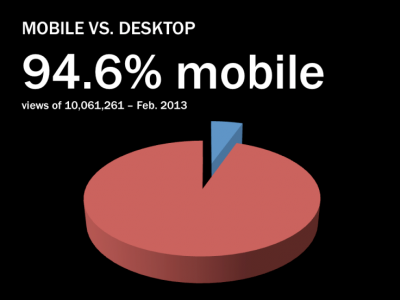
Smartphones are no longer a coveted accessory; rather, they are a reality to be reckoned with. While some transit organizations are adjusting to mobile realities quicker than others, there is much to be gained in giving mobile the attention it deserves.
FACT #1: Americans are being pushed to buy smartphones.
American cellular companies are making the switch to smartphones practically unavoidable when upgrade time comes around. There are three factors that play into this: (1) Americans love free phones, and now the free phones are smartphones. Verizon now has a selection of free Android, Windows, Blackberry and iPhones with a two-year contract. (2) Cell phone companies make more money on data. More money–that’s pretty self explanatory. And, (3) feature phones are increasingly difficult to find. Visit any major carrier’s retail store–it’s slim pickings.
FACT #2: Dependent riders have smartphones.
Smartphones are a “best buy” for low-income Americans as they have proven to be an inexpensive computer substitute and flexible Internet connection. According to the Huffington Post, “Growing numbers of low-income Americans are relying upon smartphones as their primary means of reaching the Internet.” A Pew Research report found the same, stating, “About 40 percent of people in households earning less than $30,000 say they go online mostly on their phones, compared with just 17 percent of those earning more than $50,000.”
FACT #3: Real-time transit Information is overwhelmingly consumed via mobile.
Over the past two years we’ve seen a surge in mobile access across all of our customers types. In February 2013 the pageview breakdown between mobile and desktop was astonishing. 94.6% of over 10,000,000 views were from a mobile phone.
Clearly, mobile usage is expanding….but, what does this mean for transit?
Decisions are made differently.
Transit is by nature mobile, and transit information (both real-time and schedule) should be too. The most accurate, up-to-date information is that which is happening in real time. And now, people expect to get information as it occurs. We are no longer tethered to stationary devices, but carry information in our hand. Because of this, mobile websites and mobile real-time apps are essential.
One quick indicator of how people currently access your route/schedule information is to check out your websites’ Google Analytics. Your webmaster should be able to easily run a desktop vs. mobile report. This is a great way to perform a reality check for your particular situation.
Riders desire the ability to interact.
Print bus schedules are static. Once they’re made, they don’t change. Regardless of whether the bus is running late, arriving early, or changing routes, a print schedule remains the same and leaves riders out of the loop. Mobile real-time information allows riders to interact with the data. They can view multiple routes, see exactly where the next buses are, and make important transit decisions, keeping them in control of their experience.